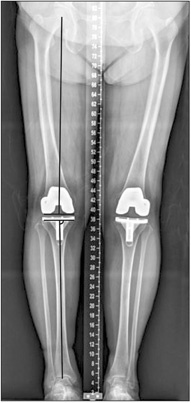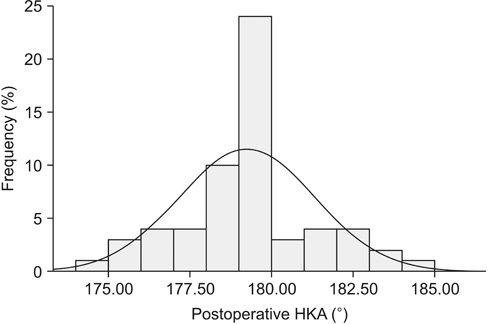J Korean Orthop Assoc.
2017 Oct;52(5):411-418. 10.4055/jkoa.2017.52.5.411.
The Advantages of Navigation for a Novice Surgeon in Performing Total Knee Replacement Surgery
- Affiliations
-
- 1Department of Orthopaedic Surgery, Catholic University of Daegu School of Medicine, Daegu, Korea. cwk1009@hanmail.net
- KMID: 2393513
- DOI: http://doi.org/10.4055/jkoa.2017.52.5.411
Abstract
- PURPOSE
To compare the outcomes of navigation-assisted total knee replacement conducted by a skilled surgeon and novice surgeon, as well as to evaluate the usefulness of the navigation assistance to a novice surgeon.
MATERIALS AND METHODS
We retrospectively made a comparison between 60 total knee replacement surgeries conducted by skilled surgeon and 60 total knee replacement surgeries by a novice surgeon during the 2015. Scanograms were taken both preoperatively and at 3-month postoperatively to measure the accuracy of bone cutting and alignment. As for external rotation of the femur, we checked the values of the distal femur surgical epicondyle axis, and the posterior condyle axis displaced by the navigator after bone registration for both novice and skilled groups. For postoperative functional examination, Knee Society Score (KSS) were evaluated at 1-year follow-up.
RESULTS
Forty-nine knees in the skilled group, and 51 knees in the novice group achieved coronal axis alignment of hip knee ankle values of 0°±3°. The mean external rotation degree of the femoral epicondyle axis against the posterior condyle axis, measured by the navigator, was 3.8°±2.9° in skilled group, and 1.2°±3.0° in novice group. When regarding femoral epicondyle axis, which showed a more internal rotation than the posterior condylar axis as an outlier, six cases were outlier in skilled group, while, 18 cases were outlier in novice group. After revising external rotation value of femoral implants comparing values navigation displaced and values using 3° external rotation manual jig against femoral posterior condylar axis, the skilled group showed 0 case of outlier and the novice group showed 10 cases of outlier. The mean KSS knee assessed at 1 year postoperatively was 83.2±6.8 in skilled group, and 83.1±7.0 in novice group, with no statistically significant difference.
CONCLUSION
Navigation provides advantages to novice surgeon to achieve stabilized coronal plane axis, as well as accurate resection of the femur and tibia. However, the navigation does not provide any advantages in achieving the aimed amount of femoral external rotation to novice surgeons.
MeSH Terms
Figure
Reference
-
1. Fang DM, Ritter MA, Davis KE. Coronal alignment in total knee arthroplasty: just how important is it? J Arthroplasty. 2009; 24:6 Suppl. 39–43.2. Bargren JH, Blaha JD, Freeman MA. Alignment in total knee arthroplasty. Correlated biomechanical and clinical observations. Clin Orthop Relat Res. 1983; (173):178–183.3. Ritter MA, Davis KE, Meding JB, Pierson JL, Berend ME, Malinzak RA. The effect of alignment and BMI on failure of total knee replacement. J Bone Joint Surg Am. 2011; 93:1588–1596.
Article4. Jeffery RS, Morris RW, Denham RA. Coronal alignment after total knee replacement. J Bone Joint Surg Br. 1991; 73:709–714.
Article5. Ritter MA, Faris PM, Keating EM, Meding JB. Postoperative alignment of total knee replacement. Its effect on survival. Clin Orthop Relat Res. 1994; (299):153–156.
Article6. Blakeney WG, Khan RJ, Wall SJ. Computer-assisted techniques versus conventional guides for component alignment in total knee arthroplasty: a randomized controlled trial. J Bone Joint Surg Am. 2011; 93:1377–1384.7. Brin YS, Nikolaou VS, Joseph L, Zukor DJ, Antoniou J. Imageless computer assisted versus conventional total knee replacement. A Bayesian meta-analysis of 23 comparative studies. Int Orthop. 2011; 35:331–339.
Article8. Cheng T, Zhao S, Peng X, Zhang X. Does computer-assisted surgery improve postoperative leg alignment and implant positioning following total knee arthroplasty? A meta-analysis of randomized controlled trials? Knee Surg Sports Traumatol Arthrosc. 2012; 20:1307–1322.
Article9. Harvie P, Sloan K, Beaver RJ. Three-dimensional component alignment and functional outcome in computer-navigated total knee arthroplasty: a prospective, randomized study comparing two navigation systems. J Arthroplasty. 2011; 26:1285–1290.10. Hernández-Vaquero D, Suarez-Vazquez A, Iglesias-Fernandez S. Can computer assistance improve the clinical and functional scores in total knee arthroplasty? Clin Orthop Relat Res. 2011; 469:3436–3442.
Article11. Kim YH, Park JW, Kim JS. Computer-navigated versus conventional total knee arthroplasty a prospective randomized trial. J Bone Joint Surg Am. 2012; 94:2017–2024.12. van der Linden-van der Zwaag HM, Valstar ER, van der Molen AJ, Nelissen RG. Transepicondylar axis accuracy in computer assisted knee surgery: a comparison of the CT-based measured axis versus the CAS-determined axis. Comput Aided Surg. 2008; 13:200–206.13. Bach CM, Nogler M, Steingruber IE, et al. Scoring systems in total knee arthroplasty. Clin Orthop Relat Res. 2002; (399):184–196.
Article14. Decking R, Markmann Y, Fuchs J, Puhl W, Scharf HP. Leg axis after computer-navigated total knee arthroplasty: a prospective randomized trial comparing computer-navigated and manual implantation. J Arthroplasty. 2005; 20:282–288.15. Oberst M, Bertsch C, Würstlin S, Holz U. CT analysis of leg alignment after conventional vs. navigated knee prosthesis implantation. Initial results of a controlled, prospective and randomized study. Unfallchirurg. 2003; 106:941–948.16. van Strien T, van der Linden-van der Zwaag E, Kaptein B, van Erkel A, Valstar E, Nelissen R. Computer assisted versus conventional cemented total knee prostheses alignment accuracy and micromotion of the tibial component. Int Orthop. 2009; 33:1255–1261.
Article17. Jenny JY, Miehlke RK, Giurea A. Learning curve in navigated total knee replacement. A multi-centre study comparing experienced and beginner centres. Knee. 2008; 15:80–84.
Article18. van der Linden-van der Zwaag HM, Bos J, van der Heide HJ, Nelissen RG. A computed tomography based study on rotational alignment accuracy of the femoral component in total knee arthroplasty using computer-assisted orthopaedic surgery. Int Orthop. 2011; 35:845–850.19. Han HS, Seong SC, Lee S, Lee MC. Rotational alignment of femoral components in total knee arthroplasty: nonimage-based navigation system versus conventional technique. Orthopedics. 2006; 29:S148–S151.20. Allen CL, Hooper GJ, Oram BJ, Wells JE. Does computer-assisted total knee arthroplasty improve the overall component position and patient function? Int Orthop. 2014; 38:251–257.
Article21. Jenny JY, Boeri C. Low reproducibility of the intra-operative measurement of the transepicondylar axis during total knee replacement. Acta Orthop Scand. 2004; 75:74–77.
Article
- Full Text Links
- Actions
-
Cited
- CITED
-
- Close
- Share
- Similar articles
-
- The Usefulness of a Simplified Navigation-Based Instrumentation for a Novice Surgeon in Primary Total Knee Arthroplasty: A Retrospective Analysis of a Randomized Controlled Trial
- Computer Assisted Navigation in Knee Arthroplasty
- The Accuracy of Lower Extremity Alignment in Total Knee Arthroplasty Using Navigation System: Data Analysis of 661 Cases
- Navigation-Assisted Knee Arthroplasty in Case of Extra-Articular Deformity or Retained Hardware
- Navigation-Assisted Total Knee Arthroplasty for the Knee Retaining Femoral Intramedullary Nail, and Distal Femoral Plate and Screws






